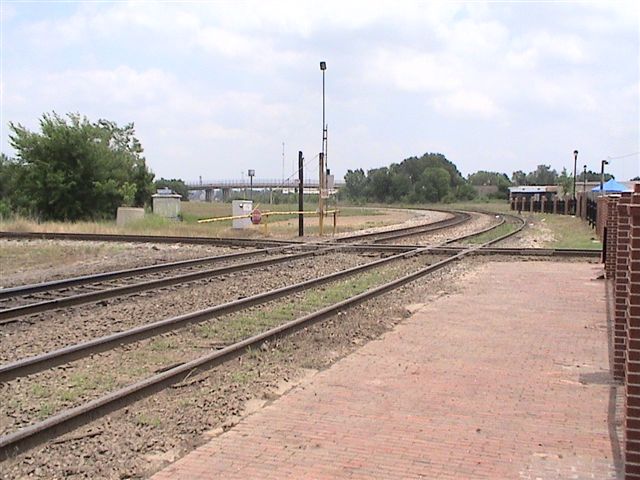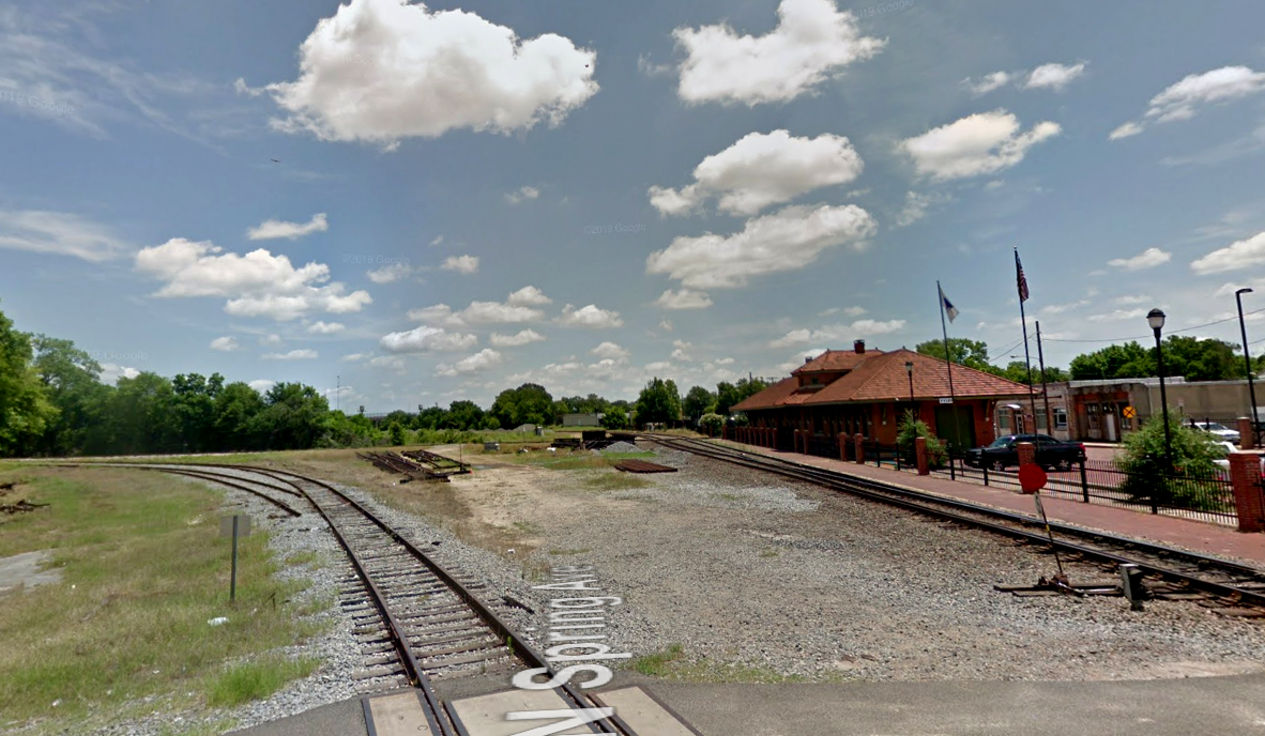
A Crossing of the St. Louis Southwestern Railway and the International & Great Northern Railroad
One of the early railroads in Texas history was the International & Great
Northern (I-GN) Railroad, a merger of the International Railroad and the Houston
& Great Northern (H&GN) Railroad formally authorized in March, 1875. The railroads had consolidated their management and operations
in December, 1872 by which time the H&GN had completed a main line from Houston
to Palestine and the International had built a main line from Longview to
Palestine. In 1873, a 44-mile branch line between the International Railroad at
Troup and the Texas & Pacific (T&P) Railroad at Mineola
was built under the H&GN charter. The H&GN laid rails through Tyler, midway between Troup and Mineola,
but they were soon operated under the I-GN name.
Prior to the H&GN construction, local citizens had recognized that Tyler was being bypassed by
both railroads: the International was 18 miles south and the T&P was 18 miles north.
This led to the chartering of the Tyler Tap Railroad in 1871 to connect with
either the T&P or the International. After the I-GN built their own line to
Tyler, the Tyler Tap chose to build a line to Big Sandy in
1877 to connect with the T&P. Unfortunately, as a narrow gauge railroad, the
Tyler Tap could not interchange cars with the T&P. Instead, trans-loading was
accomplished over a parallel siding.
In 1879, new investors came into the ownership group of the Tyler Tap and
modified its charter with expansive plans. Among the changes, the railroad was
renamed the Texas
& St. Louis (T&SL) Railway. In
1880, converting to standard gauge, the T&SL built a line from Texarkana to Big Sandy and another from Tyler
to Athens, which was extended southwest to Corsicana and Waco in 1881. Insufficient revenue forced
the railroad into receivership and it was sold in 1886 to the newly formed St.
Louis, Arkansas & Texas (SLA&T) Railway.
In 1880, another railroad was
chartered with plans to serve Tyler. The Kansas & Gulf (K&G) Short Line Railroad
proposed to build between Tyler and Sabine Pass to provide a Gulf of Mexico port
for east Texas timber products. They began by acquiring the assets of the
defunct Rusk Transportation Co. (RTC) which had built a 17-mile wooden-rail tram
between Jacksonville and Rusk in 1875. RTC's charter had been modified to extend
north to Tyler and south to Sabine Pass, hence the K&G merely planned to implement,
albeit with narrow gauge iron rails, what the Rusk Transportation Co. had
started. The 29 miles from Tyler to Jacksonville, partly using the RTC
right-of-way, was completed in 1882. Work continued; another 43 miles was built
south to Lufkin in 1885. The K&G was sold to the SLA&T in 1887 but remained a
separate entity, and in 1889, the SLA&T and K&G both went into receivership.
On January 12, 1891, two new railroad companies, the St. Louis Southwestern
Railway (SSW, more commonly known as the "Cotton Belt") and the Tyler
Southeastern Railway, were chartered to acquire the assets of the SLA&T and K&G,
respectively. The Tyler Southeastern Railway proceeded to convert the K&G narrow
gauge Tyler - Lufkin line to standard gauge in 1895. In 1899, the Cotton Belt
acquired the Tyler Southeastern.
Overview Map, Tyler Railroads

The crossing of the Cotton Belt main line and the I-GN branch line near
downtown Tyler remained uncontrolled until the 1936-37 timeframe. At that time,
Tower 183, an interlocker of unknown type, was installed, most likely a cabin
interlocker but possibly an electric gate. A gate was in place from the 1950s
until recently but it is not known to have ever controlled any distant signals
or derails, so this may not have been the original control system. The Cotton Belt came under Southern Pacific (SP) control in the 1930s
but remained officially separate until the 1990s when SP and its subsidiaries
were acquired by Union Pacific (UP).
The I-GN was
ultimately merged into the Missouri Pacific (MP) system in 1956. In 1968, having
acquired the T&P, Missouri Pacific abandoned the connection at Mineola and
removed the rails back to Lindale, 13 miles from Tyler. MP was subsequently
acquired by UP in 1982. The former Cotton Belt main line through Tyler remains
in active use today, but with both predecessor railroads absorbed into UP, the
former I-GN line from Tyler to Troup became unnecessary and was phased out of
service between Troup and Whitehouse.
Jody Garner of Tyler elaborates
(c.2008):
"The line to Troup is still intact, but inactive beyond Whitehouse which is halfway between Tyler and Troup. The line has been severed within the city of Troup. The crossing in Tyler is still active. All I ever saw at the crossing was a gate and this is dating back to the mid-50's. However, the gate is no longer there, having been removed a couple of years ago. At one time a very substantial amount of interline traffic came off of the Cotton Belt, particularly Arkansas rice which was routed to Freeport. In the 1950's, a lot of butane in Warren tank cars came from somewhere on the Cotton Belt. There was a switch engine stationed in Tyler until about 1990. The Tyler-Lindale line is still intact and active from Tyler to just south of Swan. The segment from Swan to Lindale was torn up sometime in the 1980's. North of Tyler there are still two businesses served - a scrap metal yard that ships one or two cars at a time of outbound scrap, and further north a small fertilizer plant that receives one or two cars at a time. Southward the major customer is Tyler Ready Mix. They receive 10 to 15 centerflows of cement a couple of times a week. They used to receive the same amount in hoppers of gravel, but haven't in several years. Trucks bring that commodity now. The American Standard air conditioning plant receives tank cars of Freon. In Whitehouse there's a team track where bulkhead flats of lumber are unloaded. The old MP yard near downtown Tyler has a team track for unloading boxcars of brick."
As of July, 2020, the tracks to Troup are no longer intact south of Whitehouse.
Modern Photos - Tower 183 Site (Jody Garner photos, c.2005)


Above Left:
Looking north along the former I-GN line toward Lindale, the recently renovated
Cotton Belt depot is to the left. Note the equipment cabinet at the right edge
of the image which sits at an
angle and is near where additional
Cotton Belt tracks were located parallel to the two
remaining tracks. This
cabinet may have housed
interlocker electronics. Above Right:
Looking east at the site of
Tower 183 on the former Cotton Belt line, the equipment cabinet
noted above can be seen well away from the current tracks. Sanborn Fire
Insurance maps of Tyler
from 1938 show Cotton Belt tracks proceeding into this area but the map cuts off
before the cabinet
is depicted. Below: This
Google Street View image from June, 2019 faces north along the former I-GN and
shows the gate and its mounts, two poles, and a nearby cabinet have all been
removed. The equipment cabinet in the above photos remains intact at far right.

Below: Also from
June, 2019, this Google Street View facing east from N. Spring Ave. shows that
one connecting track remains in place in the northwest quadrant.


